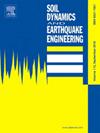周期性循环荷载作用下砂粉层状土动力特性及变形机制
IF 4.2
2区 工程技术
Q1 ENGINEERING, GEOLOGICAL
引用次数: 0
摘要
地铁路基通常由物理和力学性质显著不同的土层交替沉积而成。然而,目前的研究往往忽视了层状土的整体动力特性和微孔结构的演化。本研究采用循环三轴试验对不同高度比的均质砂、粉土和层状土进行试验,并利用核磁共振(NMR)技术研究孔隙结构和含水率的变化。从应力幅值、围压、层高比(砂粉比)等方面系统研究了土体的动力特性和宏观变形机制。结果表明:随着砂高比的增大,轴向应变和孔隙水压力先增大后减小,在hSand: h淤泥= 2:1时达到最大值;围压为100 kPa时,hSand: h淤泥= 2:1的轴向应变比淤泥高181.08%。在动荷载作用下,层状土在层状面附近形成致密的骨架结构,阻碍孔隙水的流动和耗散,使孔隙水在层状面附近发生团聚现象,加剧了残余孔隙压力的积累,降低了变形阻力。而当hSand: h淤泥= 4:1时,层理面对土体的影响明显减小,变形特征趋于均匀化。本研究通过对均匀样品的对比分析,揭示了分层土的动力特性。本文章由计算机程序翻译,如有差异,请以英文原文为准。
Dynamic behavior and deformation mechanisms of sand-silt stratified soil under intermittent cyclic loading
Subway subgrades typically consist of alternating deposits of soil layers with significantly different physical and mechanical properties. However, the overall dynamic characteristics and the evolution of micro‐porous structures in stratified soils is often overlooked in current studies. In this study, cyclic triaxial tests were conducted on homogeneous sand, silt and stratified soils with different height ratios, and nuclear magnetic resonance (NMR) was used to investigate the changes in pore structure and moisture content. The dynamic behavior and macroscopic deformation mechanisms were systematically investigated in terms of stress amplitude, confining pressure, and layer height ratio (the ratio of sand to silt height). The results show that as the sand height ratio increases, the axial strain and pore water pressure first increase and then decrease, reaching the maximum when hSand: hSilt = 2:1. When the confining pressure is 100 kPa, the axial strain of hSand: hSilt = 2:1 is 181.08 % higher than that of silt. Under the dynamic loading, the stratified soils form a dense skeletal structure near the stratification plane, which hinders the flow and dissipation of pore water, so that the pore water agglomeration phenomenon occurs near the stratification plane, which aggravates the accumulation of residual pore pressure and reduces the deformation resistance. However, when hSand: hSilt = 4:1, the influence of the stratification planes is significantly reduced, and the deformation characteristics approach homogeneity. This study reveals the dynamic characteristics of stratified soils by comparing and analysing homogeneous samples.
求助全文
通过发布文献求助,成功后即可免费获取论文全文。
去求助
来源期刊

Soil Dynamics and Earthquake Engineering
工程技术-地球科学综合
CiteScore
7.50
自引率
15.00%
发文量
446
审稿时长
8 months
期刊介绍:
The journal aims to encourage and enhance the role of mechanics and other disciplines as they relate to earthquake engineering by providing opportunities for the publication of the work of applied mathematicians, engineers and other applied scientists involved in solving problems closely related to the field of earthquake engineering and geotechnical earthquake engineering.
Emphasis is placed on new concepts and techniques, but case histories will also be published if they enhance the presentation and understanding of new technical concepts.
 求助内容:
求助内容: 应助结果提醒方式:
应助结果提醒方式:


